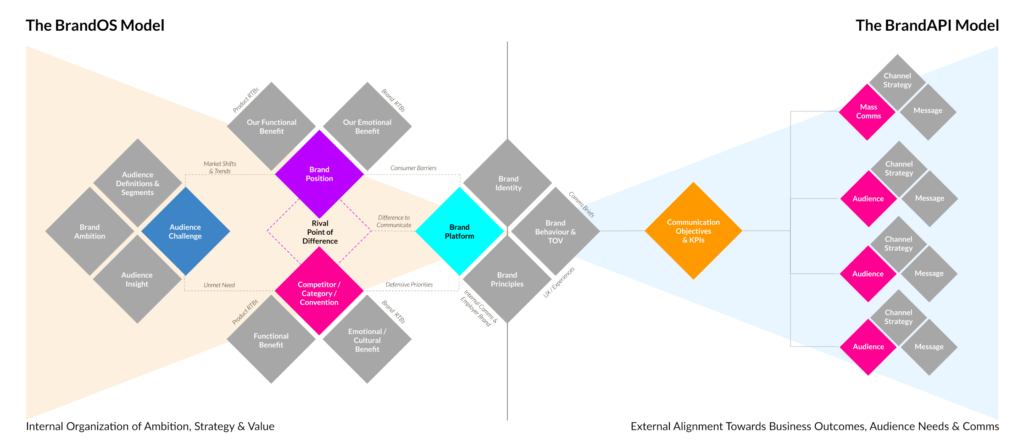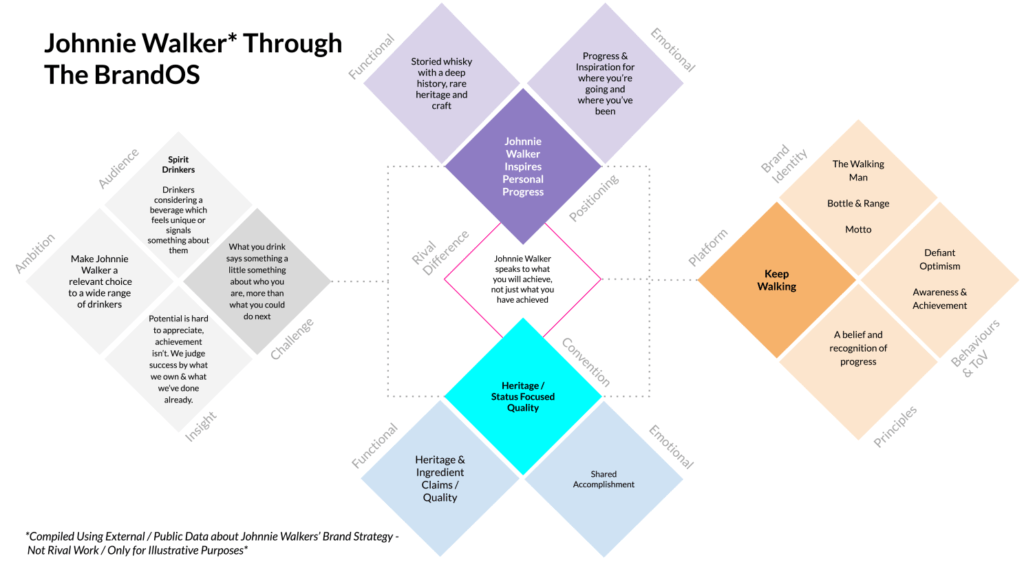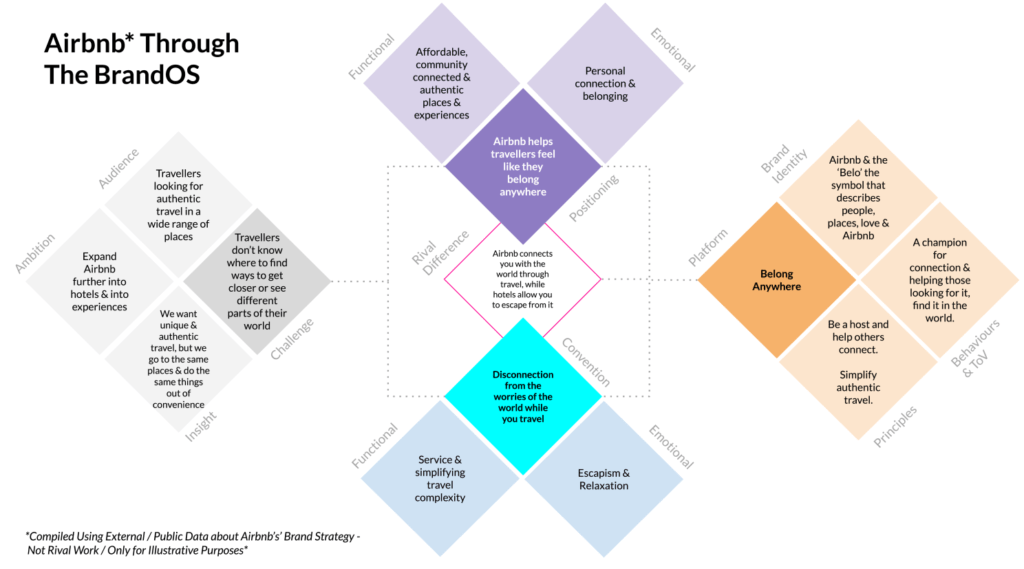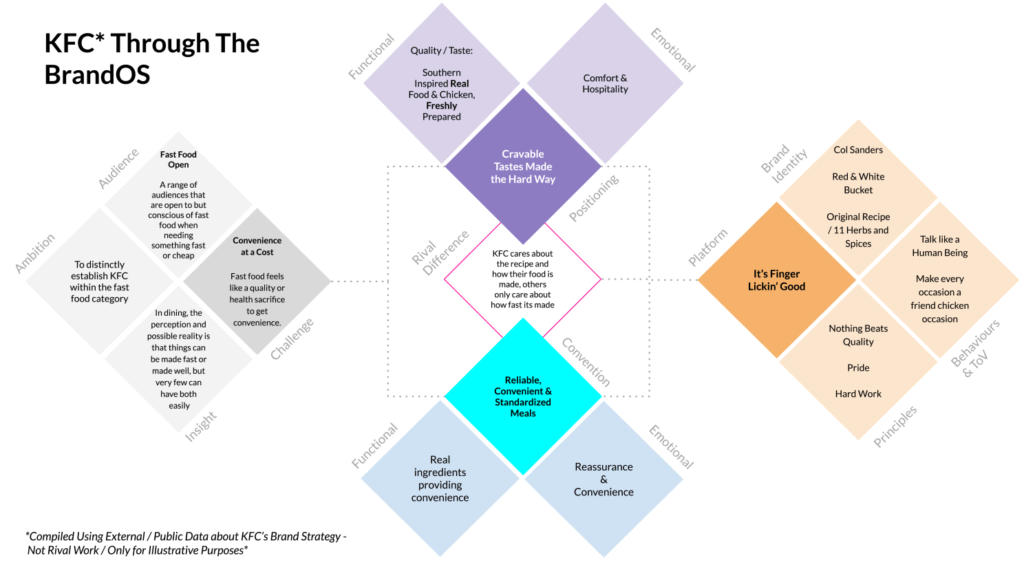
Framework: How to Build a Brand?
How do you build a brand? It goes beyond its appearance, tone of voice or advertising – it begins with a strategy that combines a blend of long term intention and short term flexibility.
Effective brands are the focal point between two tensions, the internal potential of a brand and product(s) and the opportunity and needs of the external world and culture. In my brand and campaign strategy work, I build two products to harness these forces: respectively called the BrandOS and BrandAPI. The BrandOS framework focuses on creating a strong foundation which the BrandAPI helps to stretch out into the world as it ‘goes to market’. I’ve tested this system against B2B and B2C brands, from challengers to multi-national corporations.

The Compression & Expansion of Brands
A brand must reduce the wide range of assets, products, services and partners into a clear framework – a scalable operating system that allows stakeholders to use it in the present and adapt it going forward with market changes. This BrandOS is powered by an understanding of a core audience, an audience challenge, a value proposition that solves it and a compelling point of difference – guiding the core external facing elements of a brand. Similar to a mobile phone’s OS, the BrandOS adapts in various ways, from small changes in response to market ‘bugs’ to large refreshes or ‘new versions’ alongside new technology, features or behaviour. While the ‘operating system’ metaphor for brands isn’t unique – in ours, adaptability is the key element taken from the metaphor.
However, the BrandOS is just the overall basis for the brand’s activities – it still needs to scale across different audiences, needs and experiences. Brands today are expected to offer distinctive and widely understood elements of their identity, while also being specifically relevant to different groups with different needs. To do this, brands amplify themselves to different audiences in different ways – similar to how an Application Programming Interface or API works. Built to handle different users requests and needs, an API can provide different value to different requests.
A BrandAPI works similarly, translating the core foundations of a brand in response to different ‘requests’ or experiences for different audiences and objectives. A BrandAPI stretches, but doesn’t break, the core foundations of the brand – allowing for a balance between consistent elements recognized across audiences and specific value within audiences.
Balancing Intention and Adaptation with BrandOS

BrandOS Framework and Components
The BrandOS is a system designed to set a long term goal, but allow adaptation to the market and world where needed to achieve it. Successful brands aim to be timeless, but that doesn’t mean they are unchanging – they are instead consistent in how they change. The goal of any brand strategy should be a system that empowers this, not a static brand book that gathers dust.
Our version of this system features four interconnected inputs: Audience & Challenge, Brand Position & Value, Market & Point of Difference and the External Facing Brand Platform & Identity.
The Audience & Challenge anchors a brand in the long term ambition by understanding what growth looks like and where it should come from. It identifies a ‘centre of gravity’ audience for the brand, that it must win with, to put above any existing segmentations or audience groups. The group is wide enough to power the brand towards its ambition, but specific enough to find a challenge – or higher order issue that the brand can solve. The challenge (and an insight behind it on why it matters / exists) are the criteria for what will be relevant for the brand.

Analyzing Johnnie Walker Through the BrandOS
In a world where brands are rich in possibility with potential products, benefits and proof points, what matters most is to be valuable to your core audience. The Brand Position should identify the functional and emotional value the brand provides earn a presence, organising key benefits and proof points underneath. Both the emotional and functional value a brand provides should contribute individually to addressing the audience challenge. The Brand Position should encapsulate the identified functional and emotional value in 1-2 short, compelling sentences.

Analyzing Airbnb Through the BrandOS
While a brand must provide relevant value to grow sustainably, it also needs to do it in a distinctive way. An identified Point of Difference serves as a core element of the brand, establishing where and how it diverges from the market to create its own unique position. Building the point of difference requires looking at competitors similarly to how the brand position was created, considering the functional and emotional value competitors provide. Aggregating up key components from each can create a category convention – highlighting the average functional and emotional benefit the market offers in relation to the audience challenge. It also serves as a counter balance to the brand position, the gap between which should contain a strong Point of Difference.

Analyzing KFC Through the BrandOS
Strong foundational components including the Position and Point of Difference guide how the brand creates its external identity. The brand’s platform is the guiding thought for all externally facing activity. It comes from understanding what barriers exist to uniquely activating the Position and Point of Difference externally. “What won’t our audience understand quickly?”, “How could others copy or replicate our foundations?” and “How do we honor our Point of Difference?” should all influence development of the brand platform, but also the visual identity, tone of voice, principles and communications behaviours. Each of these will demonstrate and reinforce elements of the brand foundation in their own way.
To ensure adaptability, the brandOS that’s been created shouldn’t be built linearly. Instead, it should be considered like a crossword puzzle – checked for contradictions, weak links between components and areas of vulnerability. The links between each input should also be tested for what would invalidate them. What could competitors do to dilute the brand’s Point of Difference? What consumer behaviour shifts make the value we offer less valuable? Building in key assumptions to the BrandOS and creating a plan to monitor these is key to continuously testing and updating it over time.
The BrandAPI: Distributing a Brand to the World
Modern brands face two challenges when going to market: the need to be simply understood at scale and to be as relevant as possible to specific groups. To plan a successful Go to Market strategy, brands can’t focus on one, they have to deliver both.

The BrandAPI Framework
A GTM framework which creates distinct activity focused specifically on wider ‘brand understanding and identity’ or driving relevance with individual audiences allows brands to do both simultaneously in an organised fashion.
The BrandAPI uses the external facing elements of the BrandOS as a guide in everything it does, which it stretches across different objectives and audiences. The different objectives a brand must focus on will shift faster than the foundation supporting it, creating a natural mix of long term intention and shorter term activation. From establishing salience through to driving advocacy, purchase or loyalty, communications objectives are the nodes that connect the BrandOS to the world. The barriers a brand faces to success
Each objective should spawn one or more need states and audiences that can help to achieve it. From driving salience amongst an audience looking for a distinct alternative, to expanding consideration and the product range through empowering like minded creators – every objective should help create different avenues to solve it in planning.
When it comes to audiences, a brand’s value doesn’t just exist in how to engages customers or consumers, instead it exists for a wide range of audiences from direct employees, partners, creators and influencers, as well as other brands and collaborators. Each has their own distinct needs and relationship with the brand which have to be considered in how the brand approaches, messages and reacts to them.

KFC Activity through the BrandAPI framework
The way a brand approaches different audiences is no longer one way. While employee or collaborator activity is naturally considered more ‘two way’, consumers are becoming more empowered to collaborate, under the right support, with brands. Additionally, the data and insight created by every engagement with an audience should be planned to come back to the brand – informing more about how to operate effectively.
As technologies such as generative AI increase in adoption, training these to shape the output available to consumers in favour of a brand’s desired image will become increasingly important – making technology in essence, an additional audience to consider. Additionally, brand interactions and collaborations are also becoming more expected, making other brands collaborators and gateways towards other audiences.
Each audience under an objective is the start of a brief that addresses this specific combination of considerations. This brief should take into account the nature of the audience, need state and objective, but additionally the brandOS, including the tone of voice, communication behaviours and platform, as a boundary to how need states and objectives can be activated. In essence, every brief stretches the brand to different uses without breaking it. It provides the basis for what channels are selected and how they’re used, as well as how the brand’s message is conveyed.
These briefs are the basis for more detailed strategic work, from traditional creative strategy and assets, through to influencer or creator work, brand partnerships, product development or even training external tools and data sets to empower creativity. The BrandAPI isn’t limited to traditional communications planning, it is about every experience a brand can empower or provide. It also isn’t the end of strategic development, much like traditional API architecture, its the basis for more specific development by more parties.
Conclusion: The Framework Pile is a Mountain
Despite what this piece might imply, brand frameworks aren’t as important as the output or collaboration they can inspire. The world hasn’t experienced a framework drought in some time. I don’t claim that this model is better or worse than a number of other valid options available to marketers today – but it is what I and Rival have used to find success for brands. It serves us well and hopefully sparked some questions or thoughts on how you might approach building and activating a brand. If so, comment and let me know!


